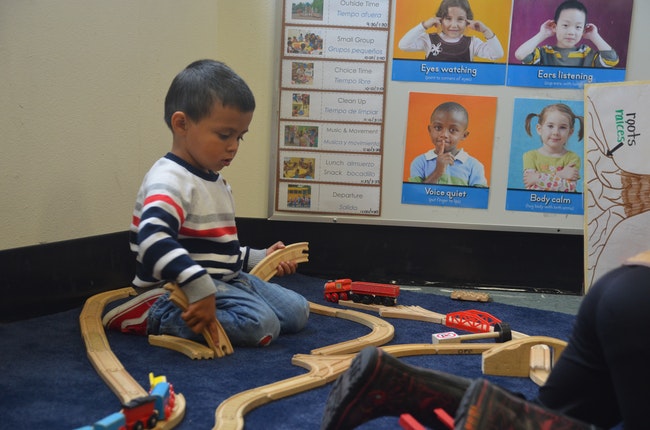
Preschool students play in a Salem-Keizer classroom (Rachel Alexander/Salem Reporter)
As Portland resident Jasmine Casanova-Dean spoke to legislators at a hearing about child care last week, her 67-year-old grandmother watched her 2-year-old daughter in another room.
Casanova-Dean can only afford professional child care two days a week, so every other day she’s left to shift her work schedule, seek help from family or friends or tell her daughter to be patient while she finishes an important work meeting.
“My story is the same as countless other parents struggling to find affordable child care,” Casanova-Dean said. “I and so many other parents shouldn’t have to choose between caring for a child and working.”
Lawmakers and Gov. Kate Brown are trying to help, though they acknowledged that the state can’t do enough to make sure every family that needs child care can afford it.
For Rep. Karin Power, the Milwaukie Democrat who leads the House Early Childhood Committee, it’s a personal issue. She has two young children in child care.
“It’s really expensive, and it’s really expensive for everybody,” Power said. “I’m hearing right now too from families who can afford care and still can’t get it because providers have closed.”
Brown called for $100 million in new spending. The Legislature’s budget writers haven’t yet decided how to spend the roughly $1.5 billion in extra state money, but there’s broad support among Democrats in the majority to spend at least some on child care.
Child care advocates back a plan that would cost just under $90 million. About half of that sum would go to grants for new child care providers and existing facilities that plan to hire more staff or otherwise expand their programs.
Supporters pointed to the San Francisco-based Low Income Investment Fund, which reported spending $168 million to create 273,000 new child care slots between 1984 and 2020. In total, that $168 million resulted in $29 billion in monetary benefits to families and communities, according to the organization.
Oregon would use another $21 million for direct payments to child care workers as incentives to stay in the workplace. Child care workers are paid an average hourly wage of $14.95, according to the Oregon Employment Department – slightly more than the minimum wage but lower than the starting salaries many retailers and fast food establishments are offering because of staff shortages.
The last $4.3 million would go to administrative costs associated with combining two state departments that dealt with child care. The Early Learning Division in the Education Department set learning standards, while the Human Services Department handled child care subsidies.
Legislators last year directed that the two functions be combined into a single new state department, and legislation under consideration this year will give extra time to form the new Early Learning and Care Department.
Pending legislation, introduced by the House Early Childhood Committee, also would increase subsidies to move closer to paying the actual cost of child care needed by low-income families. Legislative fiscal analysts haven’t estimated that cost yet.
While her committee is working on policy changes, Power said the problems with child care come down to money and how society thinks about the need to care for young children.
Once children are 5, they have access to free K-12 education. In the current two-year budget cycle, the state spent $9.3 billion on K-12 education.
State and local governments pay teachers and other school staff and build and maintain school facilities, but there isn’t similar spending on child care facilities. As a result, child care remains unaffordable for many families while those providing the care are among the lowest-paid workers in Oregon.
“I often think, ‘What if each family was expected to pay the full cost of sending their kid to school?’” Power said. “I think most people would look at me like I’m nuts if I said something like that, because it just isn’t something that we would expect. Public education is such a core tenet of our nation, but we don’t extend it to littler kids.”
Researchers at the University of Oregon have run two ongoing national surveys of families with young children and child care providers throughout the pandemic. In November, the team reported that nearly 60% of child care providers experienced “significant staff shortages,” compared to just 36% before the pandemic.
More than 85% of child care center directors said they struggled to recruit and retain qualified workers, and nearly 40% said they were ready to leave their jobs or the child care field entirely within the next year.
“These numbers are likely an underestimate, as there have been many reports showing that a large number of providers have already left the child care workforce before we asked these questions,” the report said.
Jessica Boyd, a child care worker and mother of two in Eugene, told the House committee she’s been working in child care for 10 years. More than half her monthly income went to paying for her older son’s child care when he was young, and she left work for two years when her younger child, now 8, was born because she couldn’t afford child care.
Over the past two years, Boyd said, her child care center has struggled to hire workers and reduced the number of children it accepts because there aren’t enough workers to care for them.
“If it wasn’t for my husband, I wouldn’t be able to get by on a child care provider’s wage,” she told committee members. “I could not be self-sufficient on my own income. It’s really discouraging when the people at Taco Bell are making more than me.”
Oregon Capital Chronicle is part of States Newsroom, a network of news bureaus supported by grants and a coalition of donors as a 501c(3) public charity. Oregon Capital Chronicle maintains editorial independence. Contact Editor Les Zaitz for questions: [email protected]. Follow Oregon Capital Chronicle on Facebook and Twitter.
STORY TIP OR IDEA? Send an email to Salem Reporter’s news team: [email protected].









